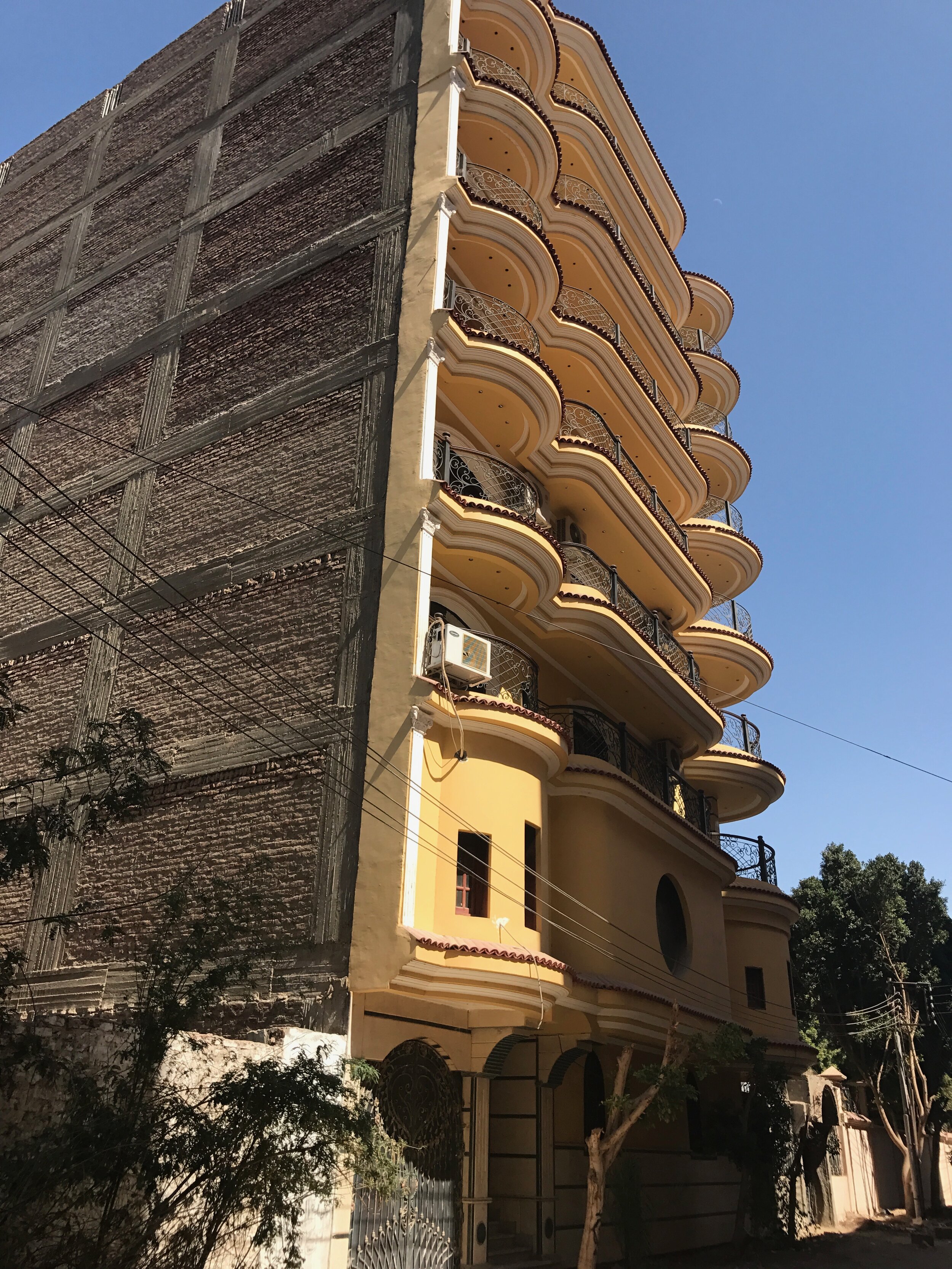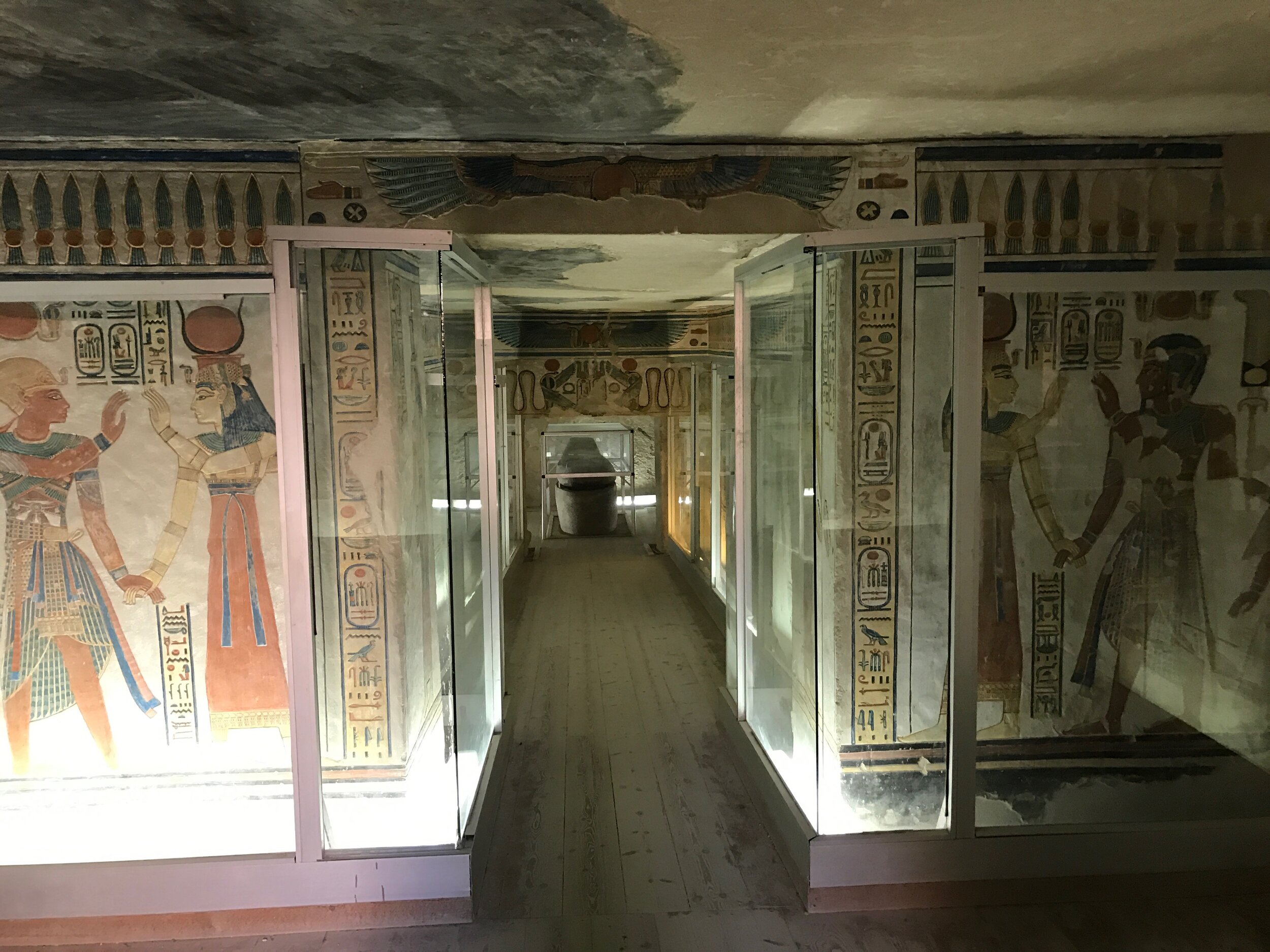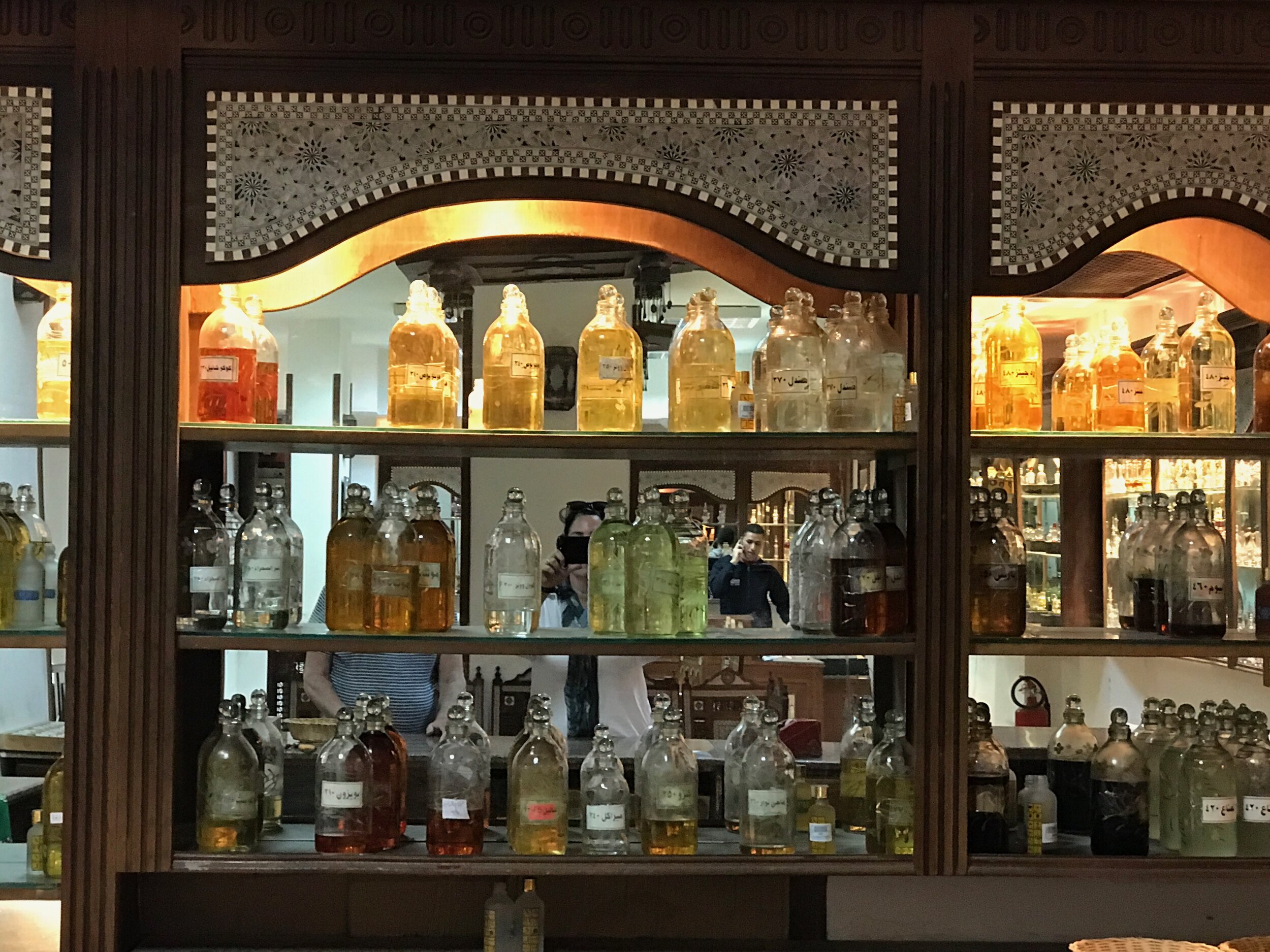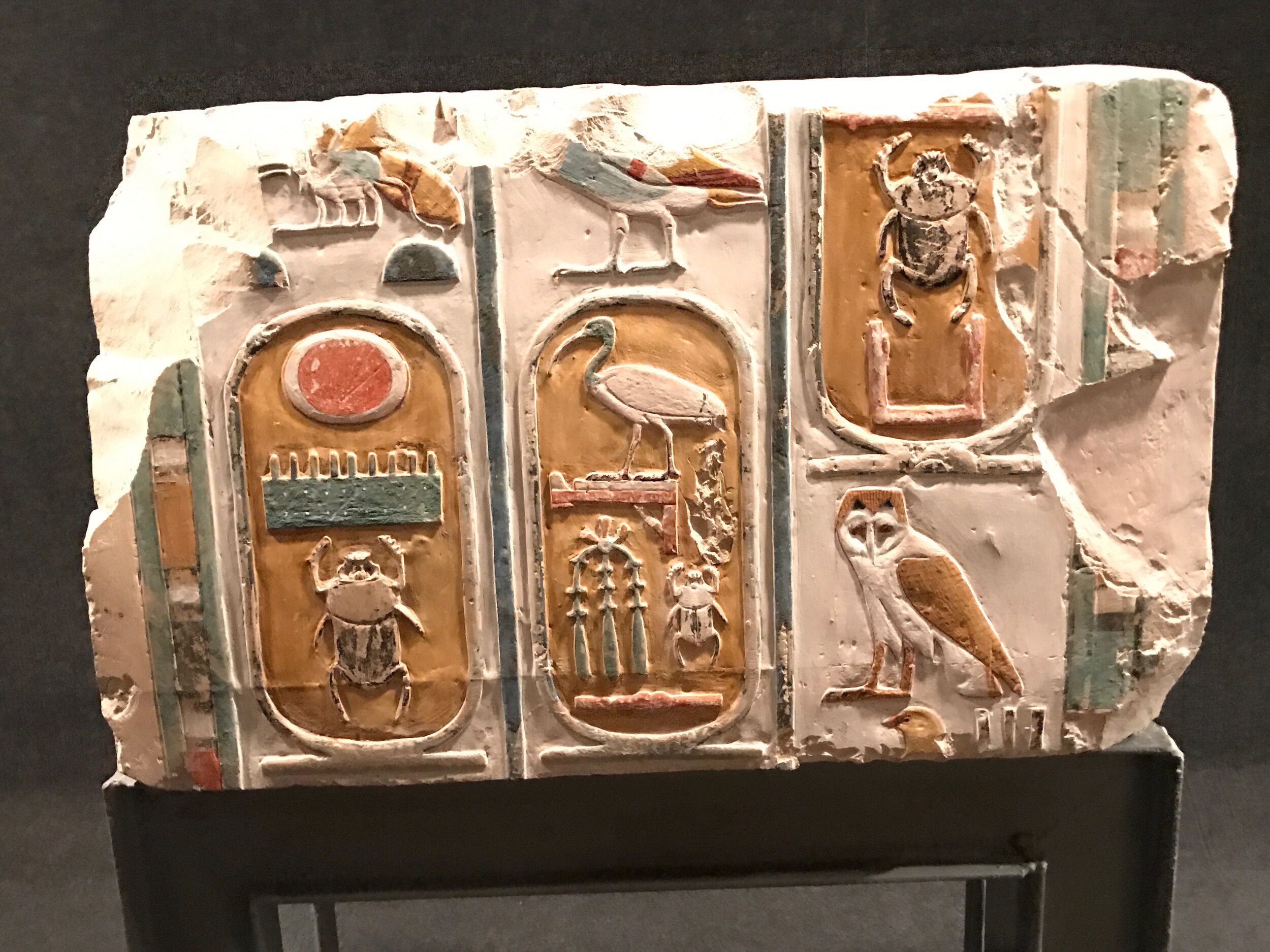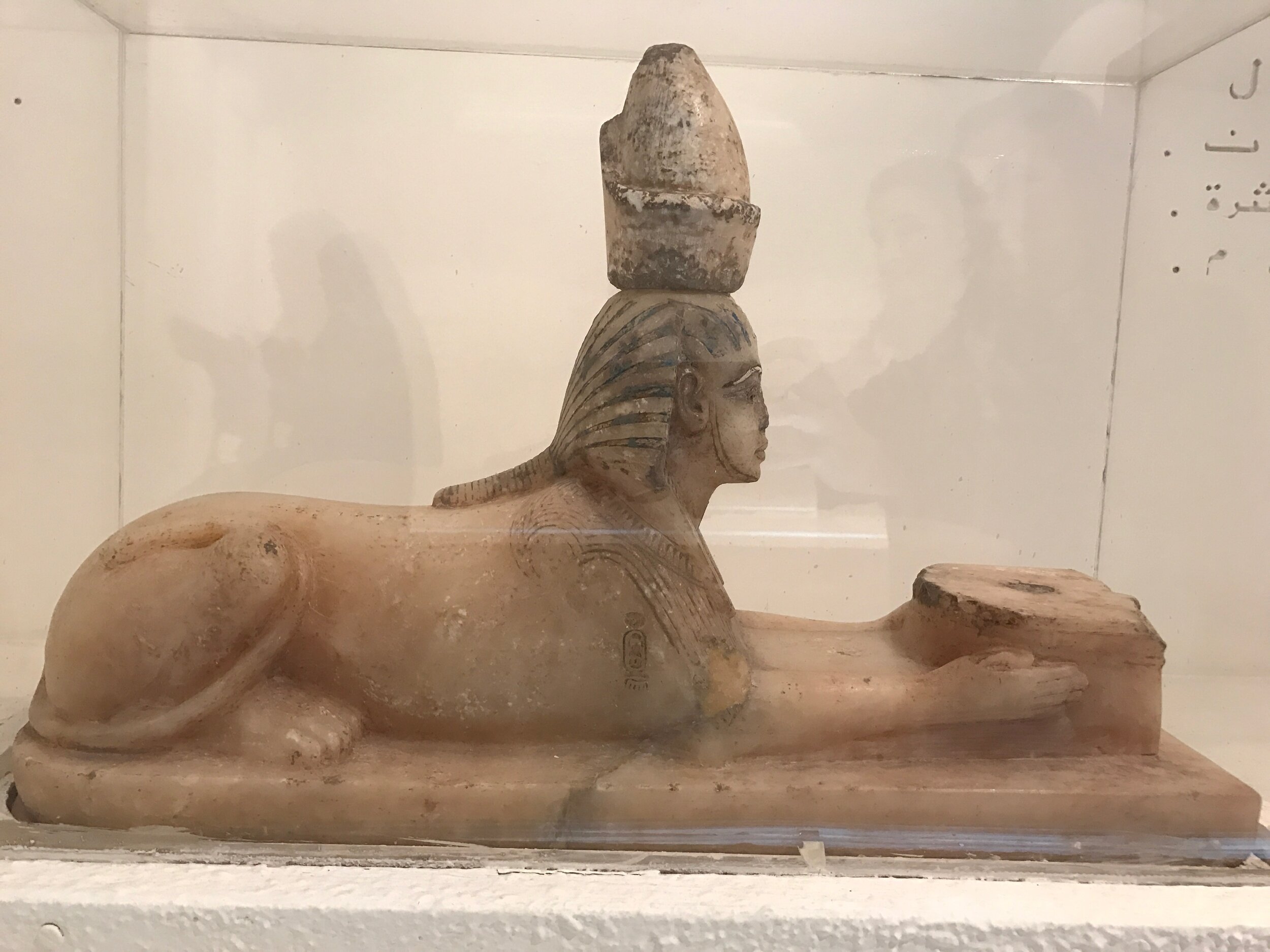[Visited In March 2017]
On our way to the Cairo Airport we passed President Al Sisi’s Palace. I noticed men with guns and walkie talkies stationed every 10-20 feet apart. They were on both sides of the road and on the median in between. There were hundreds of them lined up for miles into the very airport itself. I asked our guide about it and he said that Angela Merkel was flying in from Germany that day to open the first of three Power Plants. Interesting. When one thinks of a destination like Egypt what comes to mind is only what one has heard in the US news - tomb discoveries, terror attacks, uprisings or government overthrows. Sensational stuff but it sticks and so the mundane, and mostly positive news, is under-reported - like power plants and helpful participation between countries.
We saw this sculpture at the airport. A. used to joke that the merger of Compaq and Hewlett Packard in 2002 was like “Two rocks tied together, trying to float” This was a perfect visual representation of it.
A Prayer Room. The equivalent of the yoga room at SFO.
Egyptian Modern - Hilton-style
The lobby of the Hilton Luxor Resort and Spa is a shiny, modern interpretation of classic Egyptian elements. Black and white striped marble columns, laser cut lattice work and floral inlaid marble floors. The hotel is on the Nile and we arrived just in time for a sunset cocktail on the daybeds, with flaming torches along the river and palms blowing in the wind. Since we were there for only two nights leading to our Nile cruise, we decided to eat at the hotel and not to risk any street food that might make us sick. The hotel had several restaurants to keep us curious and fed. We ate Asian at Silk Road, Mediterranean at Olives, but skipped the Shisha ritual at the Diwan cafe. There was also The Tea Bar, which, besides tea served juice, smoothies and organic snacks.
Sunset on the Nile
The call to prayer was our daily alarm clock. It sounded particularly beautiful coming from both sides of the Nile, a little out of sync. I got up to watch the sunrise - a pink glow from the sun breaking through the smokey haze. There were small shapes rising over a distant mountain ridge, hot air balloons that got bigger as they rose higher and closer to the river.
Sunrise with Balloons
Today was to be a big day of sightseeing, so from the breakfast buffet I assembled my most ambitious Fetteri breakfast yet.
First Fetterei in Luxor
Orientation. We started in Tel Aviv (upper right) went to Cairo (middle) and on to Luxor (bottom).
Luxor, originally called Thebes, is 3000 years old and was the capital of Egypt during the Middle and New Kingdoms. It is considered the largest open air museum in the world, because of its sprawling Valleys of Kings, Queens and Nobles and the Luxor and Karnak Temple complexes. The traffic in Luxor was not as congested as Cairo. And mixed in with the cars, were motorcycles, bicycles, horse-drawn carriages and donkey-pulled carts carrying vegetables or piles of pita.
Vegetable Cart
The sidewalk edges were painted with black and white stripes and planted with palms. The streets were lined with butcher stalls and fruit vendors, filled with pedestrians, and backed by multi-leveled salmon-colored buildings. Some of the larger apartment buildings were actually single family homes. Families live together (in the same building) but separate (in their own apartments). The first floor belonged to the parents and their daughters. When the first son marries he moves to the first floor, a second son - the second floor and so on. When the daughter marries she goes to live with the family of her husband, on whatever floor corresponds to his birth order.
You would definitely want to be the seventh son in this building - Imagine his view!
Our driver and guide took us to the ‘West Bank’ - a place you are discouraged to go in Israel but are encouraged to visit when in Egypt. Because the Egyptians believed that the sun rises in the East (rebirth) and sets in the west (death or journey to the afterlife) all of the burial grounds are located on the West Bank of the Nile. Once we left Luxor behind, the countryside became lush with bougainvillea and banana palms. The ever present haze had the smell of burnt caramel from the sugarcane harvest - one of the three main crops of Egypt along with corn, and their world famous cotton. The crops on either side of the Nile stretch inland for 5 meters, other than, its just desert. All of these crops are possible because of the Nile and the series Dams that control its waters. Because of these Dams, Egyptians can now harvest crops 2-3 times per year, instead of only once a year.
50/50 House
Another source of smoke was from the brick-making industry. Official bricks are white, while red bricks use soil from the Nile, which is illegal. People build with one or the other, and some houses use both. It’s an easy way to see who is following the rules. “Egypt is like The Fight Club,” Mohamed said “the first rule of Egypt is there are no rules.” Mohamed is young, handsome and a little bit naughty. He also tells us that “Egypt is a police state - the police choose the doctors, professors and guides.” I didn’t ask if he was “chosen.”
Before we arrived into The Valley of the Kings, Queens and Nobles, we stopped at a cluster of abandoned homes known as the “Tombs of the Robbers.” Eleven years ago, the government relocated the families who lived there when they discovered that Tomb Robbers of years past had built their own tombs beneath their homes as a place to hide their loot. Of the 500 homes searched, 411 were empty. As the guide continued to relate the significance of the site, our car was overtaken by local vendors selling the kind of China-made, Egypt-inspired souvenirs that we had seen in Giza. Unfortunately, with so few tourists, they were desperate for a sale.
Abandoned Tombs of the Robbers
Tombs of the Nobles
There are 400 to 500 tombs where Nobles and High Officials are buried. They follow a similar T-shaped design, and incorporate standard ‘rooms’ - an Entrance hall, a Courtyard with inner chambers, an Offering Chapel and the Burial Chamber. The walls are painted with scenes from the lives of the owners, their families and their wishes for the afterlife. Mohamed went into detail “There are everyday life scenes like Bulimia - skinny women with bad teeth, (I did not see this) circumcision (nor this), hair salons (something similar), and harvesting beer (yes!).”
Much more discreet than the Tombs of the Robbers
Nacht Tomb 1400 BC
Nacht was the astronomer and scribe during the time of Moses, similar to a Minister of Agriculture. He was buried with his wife Tawy who, according to our guide, “She was the main bellydancer and singer for the God of Amon RA, the sun god.” Again, I didn’t find evidence of this. I think our guide liked to embellish and, even if it wasn’t true, he certainly did add some spice to the stories.
Their tomb is notable because the paintings are some of the most detailed and best preserved. Their everyday life scenes include: being entertained by musicians and dancers, offerings, and scenes of hunting and fishing. The tomb also has a False Door with spells written inside. Mohamed explains that the figures of a man are always painted in brown because they are outdoors and women are painted in white or yellow because they are indoors. Women are also painted with an exposed breast, to show they are women.
Harpists playing during beauty rituals. Women getting dressed, putting on ‘bling’ and make-up.
As I mentioned earlier, the number of tourists was minimal and so the Guards allowed us to take photographs in exchange for a few American dollars. It was incredible to see the sheer number of paintings covering every surface of the tomb, and to be able to capture the images on my camera, instead of buying poorly printed postcards from one of the vendors.
Nakht and his wife Tawy, with butchers in the lower left corner…
Tomb Chapel of Menna 1300 BC
Menna was also a scribe like Nacht with an official/agricultural title. Scribes in the valley were artisans and revered. The Egyptians were industrious, they had a 10 day week, with 3 weeks in a month and they worked 9 hours a day, 9 days a week. We heard the story of a worker who asked for 2 days off because his mother-in-law died. They went to the scribe to decide. The worker was denied because when the scribe checked his notes, he realized this was the second time the workers mother-in-law ‘died.’
Paintings in the Tomb of Menna show him supervising the harvest, fishing, and images of the journey to the afterlife - the weighing of the heart against the scarab and the eventual boat ride to the sun god. We learned that in all of the paintings, the hair is really wigs. In real life, the Egyptians shaved their head for religious purity, cleanliness, and to avoid lice. They even wore wax with essential oils on their head to smell nice. Wigs became a symbol of identity and used for protection from the sun. They were able to dye the hair, create extensions, and decorate the wigs with combs and jewelry. Often times the mens wigs were more elaborate than the women’s.
Woman with child sitting under a tree during the harvest
A scene of the harvest and grain production
Menna fishing scene
Ma’at weighing the heart against truth and justice with feather and scale
Valley of the Queens
The Valley of the Queens is where the wives of the Pharoahs are buried. It is also a burial ground for royal princes and princesses known as Ta Set Neferu “the place of the children of the Pharoahs.” There are 72 decorated tombs, Nefertari (the primary wife of Ramsses the II) is the most ornate and was restored by the Getty Conservation Institute. It takes a special ticket to see it because they worry that heavy tourism will degrade its artwork. Nefertari was one of the Top 4 Queens, along with Cleopatra, Hatsheput and Nefertiti.
Nefertari with a Cartouche above her
Anubis (the Jackal), and Osaris (the green man) escort Nefertari to the underworld
Nefertari wall close-up before restoration, with amazing depth of color
The Tomb of Ramses III son, Amen Khopshef is also here. He died young, around 9 years old and is depicted as an adolescent prince with his father, who is introducing him to the gods in the underworld.
Amen Khopsef (Left) with his father the King
Tomb painting behind glass with Amen Khopsef Sarcophagus at the end of the corridor
A fetus was also found in his tomb. It is said that his mother was pregnant and aborted when she found out that Amen had died. The sons and daughters of the kings who died young, are placed in a burial shaft which have no decoration.
It was an hour drive from the valley to downtown Luxor. I asked the guide if we could stop to buy some Egyptian essential oils at one of the many perfumeries. They are usually packed with tourists like me, who wanted to purchase oils once used for ancient rituals. Each perfumery had the same menu with different designs, advertising the same flower essences (lotus, papyrus and lily of the valley) and the same special blends (Flower of Saqqara, Secret of the Desert, and Secret of the Night). Oh, and they offer Kohl - to “beauty” the eyes.
The Perfumery
Nefertum, the God of Perfume, was also the God of Healing. In the 1870s the Ebers Papyrus was found, a scroll that detailed the medical practices of the Egyptians. It also contained 700 herbal medicine recipes using botanical ingredients. It detailed the ancient Egyptians achievements in bone-setting, dentistry, mental illness and the workings of the heart. Mohamed was excited to tell is about the first birth control method “using crocodile dung and cactus juice which repels the sperm,” (and maybe the man too? I wondered) and the first pregnancy test where “a woman urinates on barley or wheat and if it sprouts in a week - she is pregnant.”
In addition to the perfumeries, there were also many Papyrus stores. Papyrus originated in Egypt, a thick paper-like substrate used for writings and drawings. Pages bound together were called ‘scrolls’ - basically the first books. The paper was made from the papyrus plants found along the Nile, and it was also used to make baskets, sandals, ropes and even boats.
Luxor Museum
The Luxor Museum was quite a contrast to the Egyptian Museum in Cairo. Its housed in a modern building designed by a local architect, and an effort was made to acquire local, high quality artifacts and display them in spacious, uncluttered exhibits.
Examples of the Cartouche, hieroglyphic signatures inside of the ovals.
Sobek + Amenthop III
King Akhenaton with ‘God-like’ muscles
Many of the sculptures were found in the nearby Luxor and Karnak Temples. Mohamed tried to be subtle, “Each body part had a specialist to carve it. Since Kings were considered Gods, they wanted no imperfections - only god-like muscles. So the body parts were made large, even if they were small.”
My favorite piece, an alabaster sphinx with a double crown. Mohamed says the double crown looks like ‘champagne in a bucket.’
In their preparation for the afterlife, the Kings, Queens and Nobles left behind evidence of their life, rituals, and belief systems inside their tombs. With these images and writings they unknowingly gave us a glimpse into their world. It was remarkable to see how well-preserved it all is, especially after thousands of years.
I will miss young Mohameds’ efforts to modernize the history of the ancients with his references to ‘The Fight Club’ and ‘bling,’ bulimia and bellydancers, and his descriptions of their birth control and pregnancy rituals. I doubt the Egyptologists on the next part of our journey will be as colorful.








